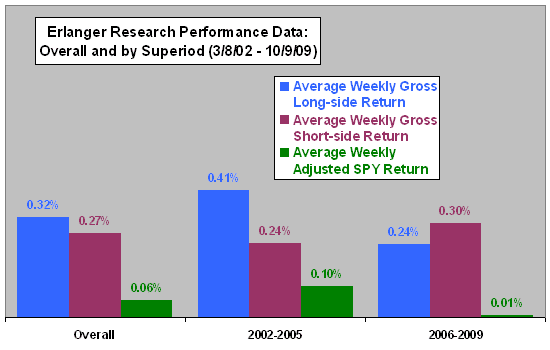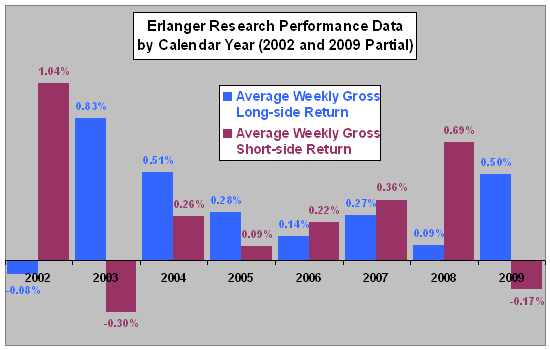A reader asked about Phil Erlanger Research: the Art of the Squeeze Play for institutional investors, which offers “research focused on delivering…advanced technical and sentiment research and data,” and the companion Erlanger Squeeze Play for private investors, which identifies “short-term trading opportunities in both long and short squeeze plays.” The core elements of this research are “short intensity and technical strength.” The performance data on the two sites are identical, but more up to date at Phil Erlanger Research. Should investors expect that portfolios built on this research will substantially outperform the market? Based on weekly self-reported performance data and contemporaneous weekly data for S&P Depository Receipts (SPY) spanning 3/8/02 through 10/9/09, we find that:
Phil Erlanger Research presents performance data in the form of weekly cumulative returns for two portfolios constructed “from a universe of mainly large cap issues,” presumably calculated based on weekly closes for selected stocks:
- “The…Short Squeeze screen selects those issues that have strong patterns and qualify as having sufficient short intensity and technical strength to be classified as short squeezes.”
- “The…Long Squeeze screen selects those issues that have weak patterns and qualify as having insufficient short intensity and technical strength to be classified as long squeezes.”
The associated “Risk Disclosure” states: “Unless specifically noted otherwise, all profit examples…are based on hypothetical or simulated trading, which means they are done on paper or electronically based on real market prices at the time the recommendation is disseminated to the subscribers of this service… Also, such examples do not include the costs of subscriptions, commissions, and other fees, or examples of other recommendations as to which there were losses utilizing the timing at the time of the recommendations. Because the trades underlying these examples have not actually been executed, the results may understate or overstate the impact of certain market factors, such as lack of liquidity… Simulated trading programs in general are also designed with the benefit of hindsight, which may not be relevant to actual trading. We make no representations or warranties that any account will or is likely to achieve profits similar to those shown, because hypothetical or simulated performance is not necessarily indicative of future results.”
The general disclaimer states: “OUR COMPANY DOES NOT WARRANT, GUARANTEE, OR MAKE ANY REPRESENTATIONS REGARDING THE USE, OR THE RESULTS OF THE USE, OF THE WEB SITES, PRODUCTS, SERVICES OR WRITTEN MATERIALS IN THE TERMS OF CORRECTNESS, ACCURACY, RELIABILITY, CURRENTNESS OR OTHERWISE.”
Results are therefore gross of search costs (Erlanger fees) and trading frictions and may impound data snooping bias or some other “benefit of hindsight.”
The following chart summarizes the average (arithmetic mean) weekly gross returns for a portfolio that is long the “Short Squeeze screen” (Average Weekly Gross Long-side Return) and a portfolio short the “Long Squeeze screen” (Average Weekly Gross Short-side Return for the overall sample period and for two approximately equal subperiods. The chart includes average weekly returns for SPY for comparison. Standard deviations of weekly returns during the overall sample period are lower for the “Short Squeeze screen” (2.02%) and the “Long Squeeze screen” (1.89%) than for SPY (2.74%).
Geometric mean (compound) gross weekly returns for the overall sample are approximately 0.21% for the long side, 0.13% for the short side and 0.02% for SPY.
The correlation of weekly returns between the long-side (short-side) portfolio and SPY for the overall sample period is 0.65 (-0.79), indicating that results are sensitive to overall market conditions.
For a more granular look at consistency, we examine gross returns by year.

The next chart shows the average weekly returns for the long-side and short-side portfolios during each of calendar years 2002-2009 (note that the 2002 and 2009 data represent less than full years). Portfolio performances do vary according to general market conditions, with the long (short) side tending to do better during bull (bear) markets.

The burden is on prospective subscribers to decide whether subscription fees, realistic trading frictions, stock borrowing costs (for the short-side portfolio) and any data snooping bias offset the gross outperformance shown above, but Phil Erlanger Research does not provide enough information (e.g., portfolio turnover and typical stock capitalization statistics) with the performance data to make this decision. A high weekly turnover weekly turnover would place a heavy burden of trading frictions (especially if the best plays are among the least liquid stocks) plausibly offsetting the self-reported long-side and short-side gross abnormal returns relative to buying and holding SPY. Actual portfolio overhead depends on account size and specific broker fees/charges. Individual investors with modest accounts and a requirement for reasonable diversification may not be able to keep portfolio overhead below a breakeven threshold.
Note that the self-reported gross hedge returns (long the “Short Squeeze screen” and short the “Long Squeeze screen”) involve incremental trading frictions beyond rotation of stocks to keep the long and short sides in balance.
In summary, available data is insufficient to determine whether Phil Erlanger’s Research is exploitable on a net basis. Portfolio overhead and biases in self-reported hypothetical returns could offset reported gross market outperformance for most investors.